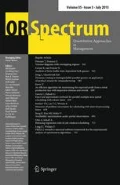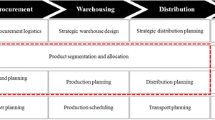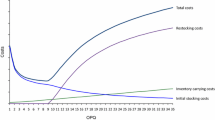Abstract
Before reaching the store, products generally flow through the retail distribution system as larger bundles, the so-called case packs (CP). In several studies these case packs have been identified as having a significant impact on distribution logistics efficiency. In this paper we develop a quantitative model and solution approach determining optimal case-pack sizes for non-perishable products in grocery retailing. The model captures the relevant operative cost drivers along the internal supply chain of a large bricks-and-mortar retailer. It explicitly represents each day of the retailer’s business week, where the replenishment doctrine considered generalizes the well-known periodic review reorder point (r, s, nq) policy as a stationary cyclic version. Exact and approximate methods are developed to evaluate the costs of a model instance. In addition, an optimization procedure is outlined that uses either exact or approximate methods to identify optimal and near-optimal CP sizes for a single store as well as for a network of multiple stores to be operated with one common CP. Applied to real-world examples of a large European retail chain, the methods reveal average cost improvement potential of more than 20% by adjusting the CP sizes that are currently in use. The approach presented is thus shown to be a valuable addition to any integrative retail supply chain planning system. Its results are directly applicable to retail practice.















Similar content being viewed by others
References
Abbott H, Palekar US (2008) Retail replenishment models with display-space elastic demand. Eur J Oper Res 186(2):586–607
Atan Z, Erkip N (2015) Note on “The backroom effect in retail operations”. Prod Oper Manag 24:1833–1834
Axsäter S (2006) Inventory control, 2nd edn. Vol. 90 of International series in operations research and management science. Springer, Boston
Broekmeulen RACM, van Donselaar KH (2009) A heuristic to manage perishable inventory with batch ordering, positive lead-times, and time-varying demand. Comput Oper Res 36(11):3013–3018
Broekmeulen RACM, Sternbeck MG, van Donselaar KH, Kuhn H (2017) Decision support for selecting the optimal product unpacking location in a retail supply chain. Eur J Oper Res 259(1):84–99
de Koster R, Le-Duc T, Roodbergen KJ (2007) Design and control of warehouse order picking: a literature review. Eur J Oper Res 182(2):481–501
DeHoratius N, Raman A (2008) Inventory record inaccuracy: an empirical analysis. Manag Sci 54(4):627–641
DeHoratius N, Ton Z (2015) The role of execution in managing product availability. In: Agrawal N, Smith SA (eds) Retail supply chain management, 2nd edn. Springer, New York, pp 53–77
Ehrenthal JCF, Stölzle W (2013) An examination of the causes for retail stockouts. Int J Phys Distrib Logist Manag 43(1):54–69
Eroglu C, Williams BD, Waller MA (2013) The backroom effect in retail operations. Prod Oper Manag 22(4):915–923
Fernie J, Sparks L, McKinnon AC (2010) Retail logistics in the UK: past, present and future. Int J Retail Distrib Manag 38(11/12):894–914
Fleischmann B (2016) The impact of the number of parallel warehouses on total inventory. OR Spectrum 38:899–920
Gámez Albán HM, Soto Cardona OC, Mejía Argueta C, Sarmiento AT (2015) A cost-efficient method to optimize package size in emerging markets. Eur J Oper Res 241(3):917–926
Gruen TW, Corsten DS, Bharadwaj S (2002) Retail out-of-stocks: a worldwide examination of extent, causes and consumer response. Washington, DC
Hadley G, Whitin T (1963) Analysis of inventory systems. Prentice Hall, Englewood Cliffs
Holzapfel A, Hübner A, Kuhn H, Sternbeck MG (2016) Delivery pattern and transportation planning in grocery retailing. Eur J Oper Res 252(1):54–68
Hübner A, Kuhn H, Sternbeck MG (2013) Demand and supply chain planning in grocery retail: an operations planning framework. Int J Retail Distrib Manag 41(7):512–530
Ketzenberg M, Metters R, Vargas V (2002) Quantifying the benefits of breaking bulk in retail operations. Int J Prod Econ 80(3):249–263
Kiesmüller G, de Kok A (2006) The customer waiting time in an (r, s, q) inventory system. Int J Prod Econ 104(2):354–364
Kuhn H, Sternbeck M (2013) Integrative retail logistics—an exploratory study. Oper Manag Res 6(1):2–18
Larsen C, Kiesmüller G (2007) Developing a closed-form cost expression for an policy where the demand process is compound generalized erlang. Oper Res Lett 35(5):567–572
McCarthy-Byrne TM, Mentzer JT (2011) Integrating supply chain infrastructure and process to create joint value. Int J Phys Distrib Logist Manag 41(2):135–161
Raman A, DeHoratius N, Ton Z (2001a) The Achilles’ heel of supply chain management. Harvard Bus Rev 79(5):25–28
Raman A, DeHoratius N, Ton Z (2001b) Execution: the missing link in retail operations. Calif Manag Rev 43(3):136–152
Reiner G, Teller C, Kotzab H (2012) Analyzing the efficient execution on in-store logistics processes in grocery retailing—the case of dairy products. Prod Oper Manag 22(4):924–939
Rouwenhorst B, Reuter B, Stockrahm V, van Houtum GJ, Mantel RJ, Zijm MWH (2000) Warehouse design and control: framework and literature review. Eur J Oper Res 122(3):515–533
Shang KH, Zhou SX (2010) Optimal and heuristic echelon (r, nq, t) policies in serial inventory systems with fixed costs. Oper Res 58(2):414–427
Simons D, Francis M, Jones DT (2005) Food value chain analysis. In: Doukidis GJ, Vrechopoulos AP (eds) Consumer driven electronic transformation. Springer, Berlin, pp 179–192
Sternbeck MG (2015) A store-oriented approach to determine order packaging quantities in grocery retailing. J Bus Econ 85(5):569–596
Sternbeck MG, Kuhn H (2014) An integrative approach to determine store delivery patterns in grocery retailing. Transp Res Part E 70:205–224
Tempelmeier H (2011) Inventory management in supply networks: problems, models, solutions, 2nd edn. Books on Demand, Norderstedt
Tempelmeier H, Fischer L (2010) Approximation of the probability distribution of the customer waiting time under an (r, s, q) inventory policy in discrete time. Int J Prod Res 48(21):6275–6291
van den Berg JP, Sharp GP, Gademann AJRM, Pochet Y (1998) Forward-reserve allocation in a warehouse with unit-load replenishments. Eur J Oper Res 111(1):98–113
van Donselaar KH, Broekmeulen RACM (2008) Static versus dynamic safety stocks in a retail environment with weekly sales patterns. BETA working papers series, 262
van Zelst S, van Donselaar KH, van Woensel T, Broekmeulen RACM, Fransoo J (2009) Logistics drivers for shelf stacking in grocery retail stores: potential for efficiency improvement. Int J Prod Econ 121(2):620–632
Wen N, Graves SC, Ren ZJ (2012) Ship-pack optimization in a two-echelon distribution system. Eur J Oper Res 220(3):777–785
Zheng Y-S, Chen F (1992) Inventory policies with quantized ordering. Naval Res Logist Q 39:285–305
Zipkin PH (2000) Foundations of inventory management, 1st edn. McGraw-Hill/Irwin, London
Author information
Authors and Affiliations
Corresponding author
Rights and permissions
About this article
Cite this article
Wensing, T., Sternbeck, M.G. & Kuhn, H. Optimizing case-pack sizes in the bricks-and-mortar retail trade. OR Spectrum 40, 913–944 (2018). https://doi.org/10.1007/s00291-018-0515-5
Received:
Accepted:
Published:
Issue Date:
DOI: https://doi.org/10.1007/s00291-018-0515-5




